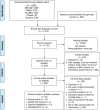Occupational Therapy Interventions for Instrumental Activities of Daily Living for Adults With Parkinson's Disease: A Systematic Review
- PMID: 34781350
- PMCID: PMC8095707
- DOI: 10.5014/ajot.2021.046581
Occupational Therapy Interventions for Instrumental Activities of Daily Living for Adults With Parkinson's Disease: A Systematic Review
Abstract
Importance: Instrumental activities of daily living (IADLs) are important for independence, safety, and productivity, and people with Parkinson's disease (PD) can experience IADL limitations. Occupational therapy practitioners should address IADLs with their clients with PD.
Objective: To systematically review the evidence for the effectiveness of occupational therapy interventions to improve or maintain IADL function in adults with PD.
Data sources: MEDLINE, CINAHL, PsycINFO, OTseeker, and Cochrane databases from January 2011 to December 2018. Study Selection and Data Collection: Primary inclusion criteria were peer-reviewed journal articles describing Level 1-3 studies that tested the effect of an intervention within the scope of occupational therapy on an IADL outcome in people with PD. Three reviewers assessed records for inclusion, quality, and validity following Cochrane Collaboration and Preferred Reporting Items for Systematic Reviews and Meta-Analyses (PRISMA) guidelines.
Findings: Twenty-two studies met the inclusion criteria and were categorized into four themes on the basis of primary focus or type of intervention: physical activity, specific IADL-focused, cognitive rehabilitation, and individualized occupational therapy interventions. There were 9 Level 1b, 9 Level 2b, and 4 Level 3b studies. Strong strength of evidence was found for the beneficial effect of occupational therapy-related interventions for physical activity levels and handwriting, moderate strength of evidence for IADL participation and medication adherence, and low strength of evidence for cognitive rehabilitation.
Conclusions and relevance: Occupational therapy interventions can improve health management and maintenance (i.e., physical activity levels, medication management), handwriting, and IADL participation for people with PD. Further research is needed on cognitive rehabilitation. This review is limited by the small number of studies that specifically addressed IADL function in treatment and as an outcome. What This Article Adds: Occupational therapy intervention can be effective in improving or maintaining IADL performance and participation in people with PD. Occupational therapy practitioners can address IADL function through physical activity interventions, interventions targeting handwriting and medication adherence, and individualized occupational therapy interventions.
Copyright © 2021 by the American Occupational Therapy Association, Inc.
Figures

Similar articles
-
Interventions for Instrumental Activities of Daily Living Among Adults With Multiple Sclerosis: A Systematic Review.Am J Occup Ther. 2022 Mar 1;76(2):7602205130. doi: 10.5014/ajot.2022.049092. Am J Occup Ther. 2022. PMID: 35226064
-
Interventions Within the Scope of Occupational Therapy to Improve Activities of Daily Living, Rest, and Sleep in People With Parkinson's Disease: A Systematic Review.Am J Occup Ther. 2021 May 1;75(3):7503190020. doi: 10.5014/ajot.2021.048314. Am J Occup Ther. 2021. PMID: 34781355
-
Interventions to Improve Social Participation, Work, and Leisure Among Adults Poststroke: A Systematic Review.Am J Occup Ther. 2022 Sep 1;76(5):7605205120. doi: 10.5014/ajot.2022.049305. Am J Occup Ther. 2022. PMID: 35943845
-
Occupation- and Activity-Based Interventions to Improve Performance of Instrumental Activities of Daily Living and Rest and Sleep for Children and Youth Ages 5-21: A Systematic Review.Am J Occup Ther. 2020 Mar/Apr;74(2):7402180040p1-7402180040p32. doi: 10.5014/ajot.2020.039636. Am J Occup Ther. 2020. PMID: 32204775
-
Occupational Therapy and the IMPACT Act: Part 2. A Systematic Review of Evidence for Functional Status, Medication Reconciliation, and Skin Integrity Interventions.Am J Occup Ther. 2022 Jan 1;76(1):7601180030. doi: 10.5014/ajot.2022.049324. Am J Occup Ther. 2022. PMID: 35019969
Cited by
-
Breaking barriers in Parkinson's care: the multidisciplinary team approach.J Neural Transm (Vienna). 2024 Nov;131(11):1349-1361. doi: 10.1007/s00702-024-02843-6. Epub 2024 Oct 17. J Neural Transm (Vienna). 2024. PMID: 39417880 Free PMC article. Review.
-
Motor and process skills of people with parkinson's disease compared to healthy older adults. A cross-sectional study.Rev Neurol. 2024 Jan 16;78(2):31-39. doi: 10.33588/rn.7802.2023231. Rev Neurol. 2024. PMID: 38223946 Free PMC article. English, Spanish.
-
Exercise Specialists' Evaluation of Robot-Led Rehabilitative Exercise for People with Parkinson's Disease.Healthcare (Basel). 2025 Jul 3;13(13):1590. doi: 10.3390/healthcare13131590. Healthcare (Basel). 2025. PMID: 40648615 Free PMC article.
-
Online Occupational Therapy as a Rehabilitation Intervention for Parkinson's Disease: A Systematized Review.Clin Pract. 2025 May 23;15(6):98. doi: 10.3390/clinpract15060098. Clin Pract. 2025. PMID: 40558216 Free PMC article. Review.
-
Delivering Multidisciplinary Rehabilitation Care in Parkinson's Disease: An International Consensus Statement.J Parkinsons Dis. 2024;14(1):135-166. doi: 10.3233/JPD-230117. J Parkinsons Dis. 2024. PMID: 38277303 Free PMC article.
References
-
- Cahn, D. A., Sullivan, E. V., Shear, P. K., Pfefferbaum, A., Heit, G., & Silverberg, G. (1998). Differential contributions of cognitive and motor component processes to physical and instrumental activities of daily living in Parkinson’s disease. Archives of Clinical Neuropsychology , 13, 575–583. 10.1016/S0887-6177(98)00024-9 - DOI - PubMed
Publication types
MeSH terms
Grants and funding
LinkOut - more resources
Full Text Sources
Medical
Miscellaneous

